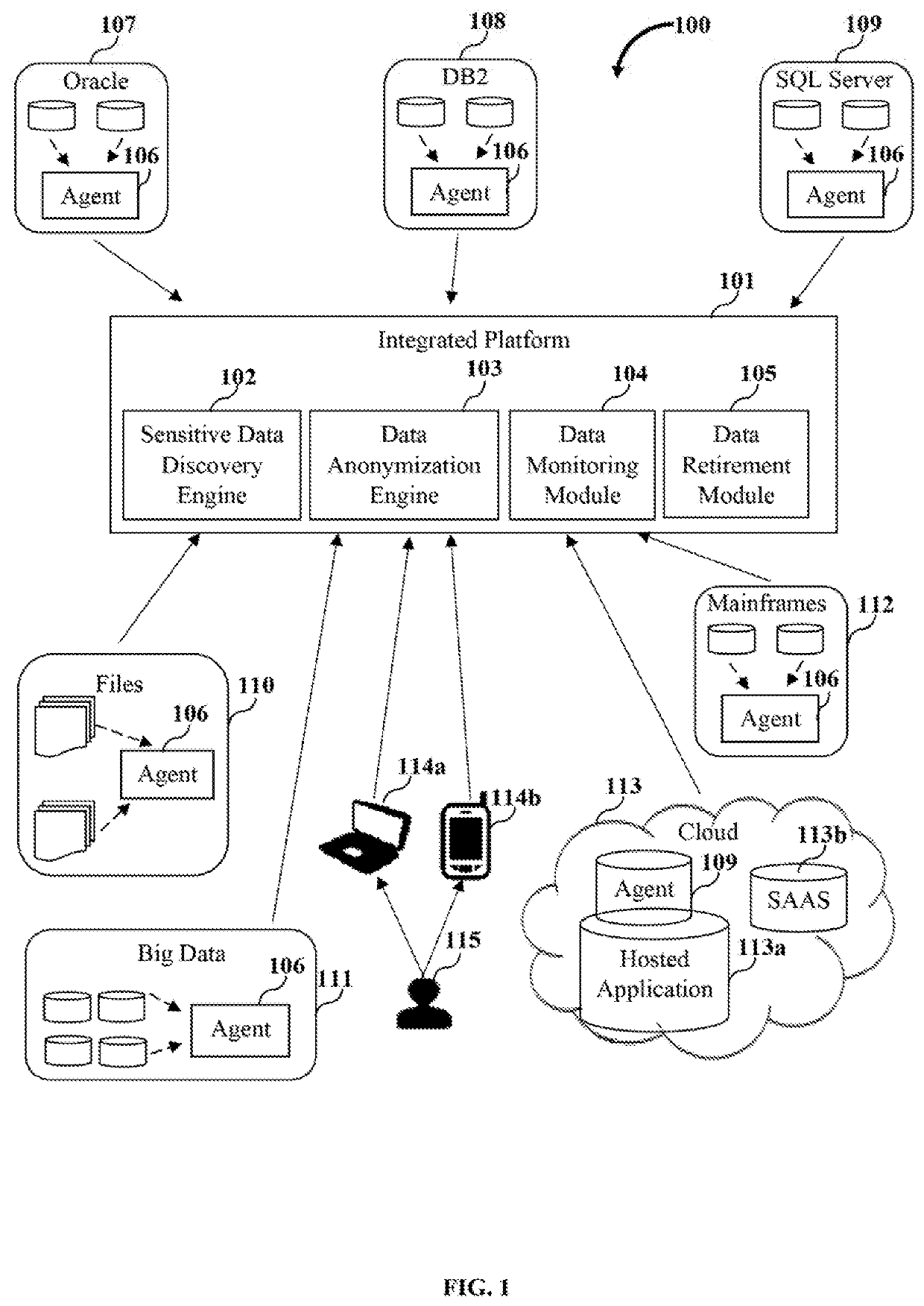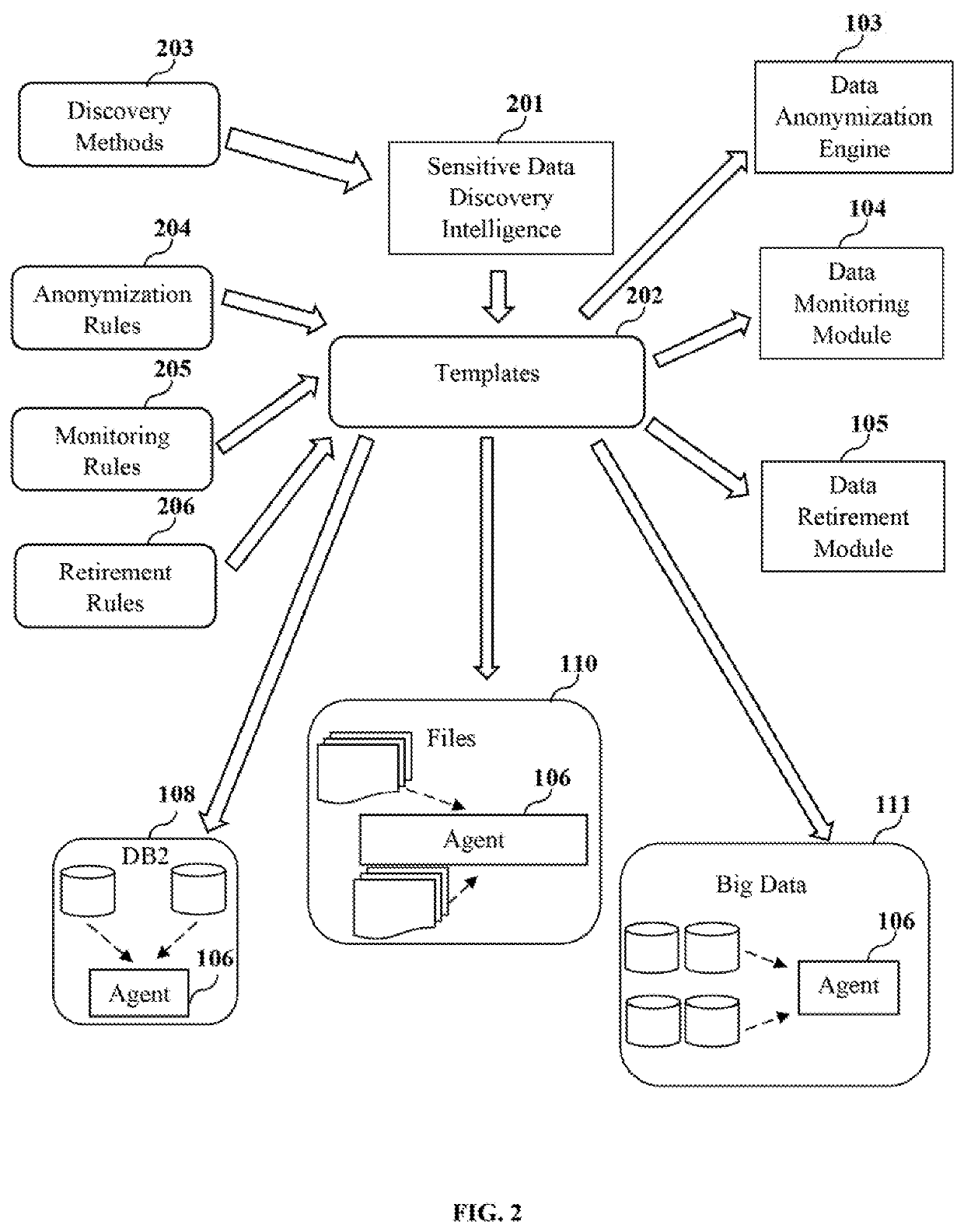This massive volume of data is difficult for most enterprises to process using conventional database and software techniques.
As most of the enterprises operate in a cloud computing environment and as volume of big data increases, most of the enterprises lose track of the locations of the sensitive data and hence find difficulty in taking appropriate measures to protect the sensitive data.
Identifying sensitive data is a challenge for several reasons.
Moreover, a database administrator or a functional expert does not have the functional knowledge and time to analyze every database in the enterprise network.
Furthermore, the data sources in large enterprises are highly complex, thereby requiring enormous human effort to discover locations of the sensitive data.
As the locations of the sensitive data are unknown, operations such as classifying, anonymizing, monitoring and detecting suspicious exfiltration events, and security of the data, become difficult tasks.
Conventional discovery methods are not scalable across data sources and applications.
The conventional methods for identifying the locations of the sensitive data have numerous challenges.
Identifying sensitive data in a database solely by conventional data dictionary-based methods are not reliable as these methods fail to identify most of the real sensitive data.
A combination of pattern matching and regular expressions is also not adequate to reduce false positives to a practicable level.
For example, usage of regular expressions and pattern matching results in more than 75% false positives.
Moreover, regular expression (regex) and pattern-based searches are unable to find sensitive data in complex columns, composite columns, BLOBs, CLOBs, key value pairs, phantom tables, etc.
Moreover, the conventional methods do not identify reasons and attributes for classifying sensitive data.
Furthermore, the conventional methods are unable to distinguish data classifications with the same patterns as they are not data classification centric.
While some conventional methods are configured to identify the sensitive data locations only, these methods do not generate metadata comprising information of the users and programs that have access to the sensitive data.
Furthermore, the conventional discovery mechanisms typically do not have a common metadata of the sensitive data across disparate databases across the enterprise.
The results obtained through these discovery mechanisms, therefore, are not effectively used in downstream data masking, data monitoring, etc.
The conventional discovery solutions also lack the ability to consistently discover sensitive data located across data sources and across applications.
Typically, the underlying database of any application is updated periodically, due to which, the sensitive data discovery process is typically performed using the conventional methods for the entire database again along with old and new data, which is time consuming and inefficient.
One goal of data masking is to obscure sensitive data such that the sensitive data is not available for any unauthorized access.
Conventional technologies, however, do not provide an integrated approach to data anonymization comprising masking, encryption and tokenization de-identification methods.
Moreover, based on business rules and security policy, if different data classifications have different de-identification requirements, a single technique may not be effective to sufficiently anonymize and de-identify all types of sensitive data.
These solutions do not perform sensitive data-centric monitoring and do not log and analyze connections and statements or programs executed by the connections along with their origins to generate alerts for unauthorized activities.
There are various challenges with the adoption of data deletion and data archival, for example, complexity in application architectures, difference in data sources such as the Oracle® database of Oracle International Corporation versus the Microsoft® structured query language (SQL) server, etc., different data retention rules for different types of data, different geographies, ability to support architectural changes during data disposal, etc.
One of the challenges with data deletion and data archival is the disposal of transactional data as most of the sensitive data is present in operational data.
Data deletion and data archival also lead to inconsistent history, which adversely affects data analytics.
Moreover, there is high likelihood that application integrity is compromised if the deletion and the archival are not complete.
Furthermore, evaluating whether deletion rules and archival rules will still work after an upgrade or a patch is applied at a data source is time intensive.
Conventional data security systems are neither comprehensive nor integrated to enable discovery, anonymization, monitoring, and retirement of sensitive data across various data sources and applications.
Some conventional solutions provide separate, discrete, standalone products for each sensitive data security operation, namely, sensitive data discovery, data anonymization, and data monitoring, and these separate standalone products are not integrated with each other.
Some conventional solutions provide partially integrated, limited combinations of data protection tools or modules for data security needs which render them inefficient and incomplete.
These conventional solutions do not integrate products that protect sensitive data across its lifecycle, which is required for consistent anonymization and complete security of the sensitive data.
Moreover, the metadata or intelligence of one data protection module is not shared or used by other data protection modules for downstream sensitive data security operations, for example, data masking, data monitoring, etc., due to a lack of integration.
 Login to View More
Login to View More  Login to View More
Login to View More 


